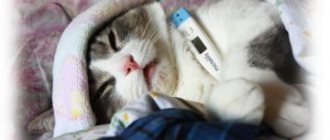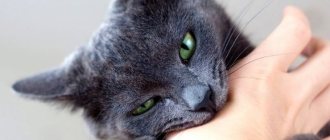6352Pavel
When there is a cat and a small child in the house, problems associated with their relationship often arise. It is not uncommon for a cat to hiss at a child for no apparent reason. Why she does this, you can answer after carefully observing her. - After what actions of the child does the cat hiss. It is only outwardly that it seems that she is doing it just like that. She definitely has her reasons to behave aggressively.
© shutterstock
A cat may hiss aggressively for several reasons.:
- jealousy,
- fear,
- protection of the territory.
Let's look at each of them.
Reasons for a cat attacking a child
If you look on the Internet for recommendations on the topics “why does a cat hiss at a child” or “why does a cat attack a child and bite” on forums, the most common answer is: “the cat takes revenge on the child out of jealousy.” People generally tend to attribute human feelings and emotions to animals, although they are simply incapable of experiencing such multifaceted emotions as jealousy, envy, resentment, etc.
Cats obey instincts, not emotions, although they have a rather gentle and subtle mental organization and can be greatly impressed by events that seem insignificant to us humans.
First, you need to understand one important thing: a cat never attacks without a reason, another thing is that they are not always clear to people. Let's list the main ones.
What cat teams are there?
There is an opinion that it is impossible to teach a cat any commands and that they are much more difficult to train than lions or tigers. However, practice shows that this is not entirely true, and that cats are quite capable of mastering simple commands: “come to me,” “stand,” “jump,” “sit,” and even “give me a paw.”
It is very important that the cat you are going to train is healthy, not scared, not stressed, and that the trainer is patient, caring and consistent in his intentions. From about six months of age, you can already teach your cat commands, following the basic principles:
- subsequence;
- regularity;
- only positive reinforcement (if, for example, your cat jumps over an obstacle, reward it with affection and treats for each such jump);
- no punishment for non-compliance;
- short-term (cats are usually tired from exercise for more than 30 minutes a day).
The most important thing that an owner must remember is that no training is worth the health and well-being of a cat.
To reward your cat, you can use dry food pellets from her main diet or wet food.
Not jealousy, but boredom
Often, with the arrival of a child in a family, pets are relegated to the background. They are given less attention, they don’t play with them, don’t talk to them, aren’t allowed into the nursery where adults spend most of their time, or even forget to feed them or clean the toilet. Of course, such changes will not go unnoticed for the cat - the animal will feel abandoned, experience discomfort and may go the “wrong way” in attempts to attract attention.
Treatment of complications after a bite
Regardless of the size of the wound, the baby should be shown to a traumatologist. The surgeon will carefully examine the wound, clean and treat it, and apply a disinfectant bandage. If vaccination with tetanus toxoid was carried out a long time ago, the child is prescribed a tetanus vaccination. If the bite was inflicted by a stray cat or one whose owner cannot present a document on the animal’s vaccinations, the victim is vaccinated against rabies with anti-rabies serum according to the scheme.
If swelling or redness is observed, topical antibiotics for the cat bite are recommended. They are used in the form of an ointment:
- Gentamicin;
- “Levomekol”;
- Tetracycline;
- Levomycetinova.
In case of inflammation and suppuration of the wound, the doctor makes an incision and carefully cleans the wound surface from the accumulation of fluid and necrotic tissue. It is washed with antiseptics (Chlorhexidine or Miramistin) and cauterized with iodine. Be sure to apply a loose bandage, which should be changed daily. To prevent blood poisoning, treatment of a cat bite is supplemented by oral antibiotics:
- Azithromycin;
- Amoxicillin;
- Gentamicin K.
Attention! If sepsis is suspected, antibiotics should be prescribed by a doctor. He selects the drug based on tests and calculates the dosage individually. Self-medication is fraught with deterioration of the condition and can lead to serious consequences.
During antibiotic treatment, the child should be given probiotics, which help restore intestinal microflora and strengthen the immune system.
To heal, the wound is lubricated with Solcoseryl ointment 2 times a day. It contains components that accelerate tissue regeneration, preventing the formation of scars. Proper nutrition and vitamin complexes will improve the well-being of the little patient and support the body’s defenses.
Territory threat
Cats perceive your home as their own, safe territory, where they are the rightful owner. If a small “stranger” suddenly appears in its possession, the animal experiences stress and perceives the child as a threat to its safety. In some cases, the cat will try to avoid the “alien”, and in others it will begin to take action to protect its space.
Leadership in the cat family
When kittens switch to adult food and learn to defend themselves, they become independent and enter adulthood.
During this period, they cease to be cat children and become competitors for the attention of their owners, for the best tidbit, for territory. Hierarchy is very important in cats
When kittens switch to adult food, they become independent and enter adulthood.
At this age, it’s time to separate the cat and kittens and find a new home for the kittens. In special cases, you can try to endure and let them figure out for themselves who will be at what social level and themselves obey the subsequent rules established by the animals.
Excessive and inappropriate touching
Children under two years old reflexively grab everything with their hands, including cats. The idea of someone else’s body as one’s own, that is, the ability to transfer one’s own sensations to other living beings, is not immediately formed in children. You want to touch soft fluffy cats endlessly, so it’s not surprising that children show excessive zeal in their caresses.
Hissing is inherent in this breed
In some cases, a cat hisses because it is inherent in its breed. Let's say Siamese hiss due to the inherent behavior of this type of temperament. Some active breeds start to hiss because they don't get enough exercise. These are Abyssinian, Oriental, Cornish Rex and some others. Some furry breeds (Persians) hate it when they wash themselves and immediately start petting them. And there are hairless cats (Egyptian breed) - they hiss constantly, because hissing is part of their conversation, and does not necessarily mean aggression.
Misunderstanding Cats' Body Language
By correctly reading a cat's body language, you can easily understand whether she wants to play, sit on your lap, or prefers to be left alone. The following signs indicate a cat’s dissatisfaction or its readiness to attack:
- licking lips;
- tail trembling nervously or striking in different directions;
- hiss;
- turning the head away from the person;
- flattening of ears;
- a dull “humming”, similar to a howl.
Fear
The enmity between cats and children is not difficult to understand. Animals prefer a quiet, calm environment and are kept to respect territorial rights. Young children are usually eccentric, fussy and very noisy. The child, despite the signals given, behaves aggressively and noisily, thereby causing fear in the animal, bordering on horror. In such a situation, a cat will not only hiss or growl, but may also rush at a person. In addition to the noise, the cat may be embarrassed by the unfamiliar smell of the baby; in order to remove these negative emotions, you need to gradually accustom it to it.
© shutterstock
It is useful if the child plays with the pet with shared toys specially designed for this occasion . If a cat accidentally or intentionally scratches a child, he will remember it for a long time. Now he knows that the animal is not a toy, and will be afraid of it. After such an incident, he often takes revenge on the animal for its reluctance to communicate and the pain caused. The best form of defense is attack. Therefore, the baby can just hit the kitten. It is important to explain to the child that doing this is bad, that the pussy also hurts. Try to explain to him why the cat attacks. After a certain time, the animal will cease to be afraid of the child, and therefore hiss and rush at him.
What needs to be done to stop the cat from attacking?
We invite you to read the recommendations on how to prevent a cat from attacking a child.
Don't forget about the cat
Most cases of “attacks” of domestic cats on humans occur due to playful aggression - the cat does not waste its energy, does not realize its predator instincts in any way and, suffering from boredom, rushes at any moving object, be it the owner’s legs or a baby running around the room.
The busyness of young parents is easy to understand and accept, however, try not to forget about your pets, spend time with them, communicate and, of course, play. An animal that feels like a full-fledged, beloved member of the family is unlikely to behave aggressively.
Be present when the cat and child communicate
Do not leave the cat alone with the child until the baby reaches an age when it is possible to negotiate with him. In addition, your presence allows you to first show and then explain to the child how to properly communicate with an animal.
Teach your child cat body language and proper touching
Draw your child's attention to signs of anxiety and displeasure in the cat when it needs to be released and left alone. Show your child how to stroke a cat correctly - movements should be smooth, gentle, without pressure. Stroking should be carried out in the direction of hair growth, in the area of the head, neck, back, but it is better not to touch the area of the tail, belly and paws. Also teach your child not to scream or make noise when the cat is nearby, explain that loud noises scare her.
Show how to hold a cat correctly
A child under 5–6 years old should not be allowed to hold a cat. It is better to sit the baby, for example, on the sofa, and only after that give him the animal in his hands. For older children, show the correct position of a cat when hanging - with one hand you should hold the animal under its hind legs, creating reliable support, and with the other you should clasp its body under its front legs.
You cannot hold your pet like a baby - belly up; this position is extremely uncomfortable for the cat, as in it it feels defenseless. You should also explain to the child that as soon as the pet expresses a desire to leave, it must be carefully lowered and under no circumstances thrown onto the floor.
Learn to choose the right games
Strictly prohibit your child from playing with the cat with his hands so that she does not perceive any part of the human body as prey. You can only use toys that are specially created for animals - they are tested for safety. Aggressive games with a cat are extremely undesirable - chasing it throughout the apartment, “attacking” it from around the corner with screams or “growling”. Such actions naturally frighten the animal, and fear can cause a defensive reaction in the form of aggression.
Provide your cat with shelter
The cat should have a quiet and reliable shelter, where she can hide from the playful baby, relax and put herself in order. Explain to your child that the cat needs personal space and a break from playing; there is no need to force it out from under the sofa or from the closet if it does not want to go out.
Reward your cat for good behavior
Treats are one of the most wonderful means of establishing friendly relations between a cat and a person. If you reinforce positive behavior with something tasty, the cat will do so in the future. If a child gives treats, the cat will develop a positive association with him.
Don't punish
If a cat shows signs of aggression towards a child, sneaks up on him and is ready to attack, it is important to leave the cat alone and leave the room with the child. There is no point in punishing a cat - she still does not understand such methods, and in some cases she sees punishment not as a means of intimidation, but as a challenge.
Alarming symptoms of a bite
Most often, a situation arises when a cat bites a child on the hand. Often children try to kiss an animal, so the baby’s nose or cheek may also be damaged. Sharp teeth severely injure delicate skin, so drops of blood protrude from the wound. It is important to observe the bite site and immediately consult a doctor if alarming symptoms appear:
- body temperature increased;
- the joint or limb is severely swollen;
- the wound has acquired a bluish tint;
- the skin on the finger is red and hot to the touch;
- the child looks lethargic and drowsy;
- Drops of cloudy liquid protrude from the wound.
You should definitely show your baby to a doctor if the cat has bitten the child in several places or if a large area of the epidermis has turned red. It is necessary to prevent the development of painful shock, which is no less dangerous than infection. Sometimes stress from a cat’s aggressive behavior provokes psychological trauma, which can be accompanied by the development of enuresis, insomnia, and a nervous breakdown.
Cases where a cat bites a child on the street are especially dangerous. The animal may be stray, and its bite may cause infection with rabies. This dangerous disease cannot be treated, develops quickly, and can be fatal. Once symptoms appear, it is no longer possible to stop the infection, so the initial visit to a surgeon or pediatrician should occur within 10–12 hours after the injury.











